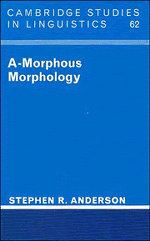Book contents
- Frontmatter
- Contents
- Acknowledgments
- Introduction
- 1 The study of word structure
- 2 Why have a morphology at all?
- 3 Is morphology really about morphemes?
- 4 The interaction of morphology and syntax
- 5 The theory of inflection
- 6 Some complex inflectional systems
- 7 Morphology in the lexicon: derivation
- 8 Clitics are phrasal affixes
- 9 The relation of morphology to phonology
- 10 How much structure do words have?
- 11 Composites: words with internal structure
- 12 Morphology and the typology of languages
- 13 Morphological change
- 14 Morphology as a computational problem
- References
- Index
9 - The relation of morphology to phonology
Published online by Cambridge University Press: 10 January 2011
- Frontmatter
- Contents
- Acknowledgments
- Introduction
- 1 The study of word structure
- 2 Why have a morphology at all?
- 3 Is morphology really about morphemes?
- 4 The interaction of morphology and syntax
- 5 The theory of inflection
- 6 Some complex inflectional systems
- 7 Morphology in the lexicon: derivation
- 8 Clitics are phrasal affixes
- 9 The relation of morphology to phonology
- 10 How much structure do words have?
- 11 Composites: words with internal structure
- 12 Morphology and the typology of languages
- 13 Morphological change
- 14 Morphology as a computational problem
- References
- Index
Summary
Up to this point, our attention has focused primarily on the principles by which morphological material is introduced into words (i.e., the operation of Word Formation Rules) and on the interaction of those principles with the regularities of syntactic structure. We have as yet said little about the rules that directly govern regularities of sound structure or phonology. In this chapter, we discuss the interaction of word structure with phonology.
In the general domain of rules determining the phonetic forms of words, we can distinguish two broad classes: Morphological rules (i.e. Word Formation Rules, both inflectional and derivational); and Phonological rules. Morphological rules have a Structural Description referring to morphological material (either a Morphosyntactic Representation or an input lexical item), while phonological rules look exclusively at the phonological composition of a form. We have already seen (in chapter 2) that purely phonological rules have properties that are distinguishable from those sensitive to morphological categories – a conclusion that is probably uncontroversial for the set of clear Word Formation Rules that actually create the markings for such categories. We will suggest below the two sorts of rule may also have very significant similarities with respect to their Structural Changes, though that alone is no reason to doubt that the distinction is still worth making.
- Type
- Chapter
- Information
- A-Morphous Morphology , pp. 224 - 255Publisher: Cambridge University PressPrint publication year: 1992



